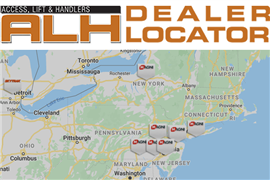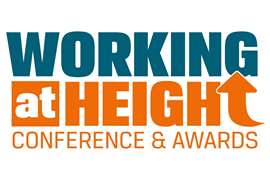Spotlight on low-level access in North America
04 May 2022
Safety, worker compensation costs and efficiency are three main factors driving demand for low-level access. Lindsey Anderson covers the latest.
In the 1970s, construction industry professionals relied almost exclusively on ladders and scaffolding to access major work-at-height projects,” says Scott Owyen, director of training, North America, for Genie. “In the decades since their introduction, MEWPs have become increasingly common, but the question still surfaces: Is a MEWP or scaffolding the right choice for my jobsite?”
 A Genie GS-1932m (Photo: Genie)
A Genie GS-1932m (Photo: Genie)
Genie addressed this question last year when the company debuted its micro scissor lift line, consisting of the GS-1932m and GS-1432m units.
“Although Genie’s micro scissors are designed to meet the needs of space-restricted and low-floor-loading applications, they also are a good choice for other jobs where you would use a standard-sized scissor lift,” says Christian Dube, product manager, Genie.
“With a 500-pound capacity, both the GS-1932m and GS-1432m are rated for two workers and feature a 32-inch-wide platform and 2-foot extension deck, ensuring good access to work locations — making them a truly versatile, do-it-all machine for any jobsite and in any rental fleet.”
Demand for low-level access
Versatility, safety and productivity are three key factors fueling demand for low-level access units – and manufacturers have been busy debuting new self-propelled and manual products to answer the call.
 Snorkel’s S3008P (Photo: Snorkel)
Snorkel’s S3008P (Photo: Snorkel)
Snorkel’s S3210P is one such unit. “Developed in response to customer demand, the S3210P offers the same operation and serviceability as the indoor-rated unit, yet is rated up to a maximum wind speed of 12.5m/s,” says Snorkel CEO Matthew Elvin.
“Equipped with an auto-brake system as standard to prevent movement when the lift is raised, the S3210P can be easily pushed when stowed between work areas and carried in a passenger elevator. With saloon-door style entry gates, non-marking casters and simple push-button controls as standard, the Snorkel S3210P is built tough.”
In the U.S., Snorkel said it is working hard to grow the visibility of low-level products within the rental channel, including placing units on display in rental branches across the country to encourage conversations between rental stores and customers. They have also used tradeshows to give away units.
Safe access
“We saw a need in the market to prevent falls which is why we launched Hy-Brid Lifts in 2004, introducing low-level access to the aerial platform industry,” explains Justin Kissinger, marketing manager for Hy-Brid Lifts. “Our current ‘Ladders Last’ campaign features weekly posts with informational statistics, infographics, blogs and videos that discuss the dangers and costs of ladders, as well as guiding users to safer low-level access solutions.”
 A ZT-1630 by Hy-Brid Lifts (Photo: Hy-Brid Lifts)
A ZT-1630 by Hy-Brid Lifts (Photo: Hy-Brid Lifts)
Hy-Brid’s most recent launch in this sector was the Zero-Turn Series ZT-1630. According to Kissinger, the ZT-1630 has a work platform averaging 96 percent larger than mast lifts which “allows operators to work at height safely without compromising workspace due to a mast.”
It also has a 650-pound platform capacity, 22-foot working height, 25 percent gradeability, 30-inch EZ-Glide slide out extension deck, electric drive and steer, low floor load pressures, full height cantilever gate, proportional controls and active load-sensing.
Safety at height
At JLG, the “ladders last” mentality has been instilled in company culture – and product engineering – for more than a decade, says Misty Mason, product manager for the company. Mason agrees that demand for these lifts continues to grow as companies place more focus on replacing ladders and scaffolding.
Ladder falls and overuse injuries as the result of ladder use have many negative outcomes, including not only injury, but also lost time, reduced productivity and costly workers’ compensation claims.
 JLG’s 1030P (Photo: JLG)
JLG’s 1030P (Photo: JLG)
JLG designed the 1030P to give operators more platform space to complete work in a single lift.
“The 1030P lift delivers a class-leading 30-inch by 60-inch platform, making it a more productive and safer choice than a traditional ladder by providing access to a larger work area without the need for repositioning,” Mason says.
“Its 550-pound platform capacity allows for ample tools and materials to be brought to the workspace, thereby reducing user fatigue associated with ascending and descending a ladder.”
Eco-friendly access equipment
Skyjack most recently debuted its new SJ12 E and SJ16 E zero-emission units that feature improved duty cycles of up to 30 percent, meaning less charging, less power consumption and a lower carbon footprint.
 The new SJ16 E from Skyjack (Photo: Skyjack)
The new SJ16 E from Skyjack (Photo: Skyjack)
The SJ12 E and SJ16 E have working heights of 18 feet and both units feature the new green ECO label accompanied by an ECO Matrix that details additional sustainability benefits.
“As governments around the world are increasingly promoting a more sustainable agenda, it’s increasingly down to rental companies and contractors to meet emission regulations,” adds Ken McDougall, president, Skyjack. “Our new models are examples of how we’ve been able to bridge practicality with sustainable efficiency by decreasing the overall carbon footprint for our customers.”
Safer work practices
While ladders and scaffolding have been utilized on access projects for decades, today’s low-level access products can lend themselves to better – and safer – work practices.
“Our advice is simply that end-users need to give these a try,” Mason says. “Rent one, then get feedback from employees on the comfort and effort level versus using a ladder. If employees feel more confident when using these, determine if they’re a fit for your business.”
What’s in store?
ALH asked manufacturers what they expect the market to be like for low-level access this year. Here’s what they had to say.
Rafael Bazzarella, product manager, Skyjack: “In line with rental, demand for low-level access is strong and the trend suggests it may well grow at a slightly larger rate than other segments.”
Christian Dube, product manager, Genie: “I’d expect that demand will continue to be high, and maybe even grow, as operators realize the safety and productivity benefits that can be gained from using MEWPs for low-level access.”
Matthew Elvin, CEO, Snorkel: “Globally, low-level access sales had slowed slightly during 2020 and 2021 due to some construction projects being postponed during the pandemic. However, 2022 has started strongly for Snorkel with very high levels of demand for all low-level models, particularly in the U.K. and Europe. In the U.S., demand for these products continues to increase.”
Justin Kissinger, marketing, Hy-Brid Lifts: “We anticipate seeing more low-level scissor lift options becoming available throughout the year to fill this growing need.”
Misty Mason, product manager, JLG: “Popularity for these types of lifts has grown rapidly in the last 12 months, and we see the market for low-level access to hit a new market inflection point.”
MAGAZINE
NEWSLETTER
The gold standard in market research
Off-Highway Research offers a library of more than 200 regularly updated reports, providing forensic detail on key aspects of the construction equipment industry.
Our detailed insights and expert analyses are used by over 500 of the world’s largest and most successful suppliers, manufacturers and distributers, to inform their strategic plans and deliver profitable growth.







